Inventory Management for Shopify
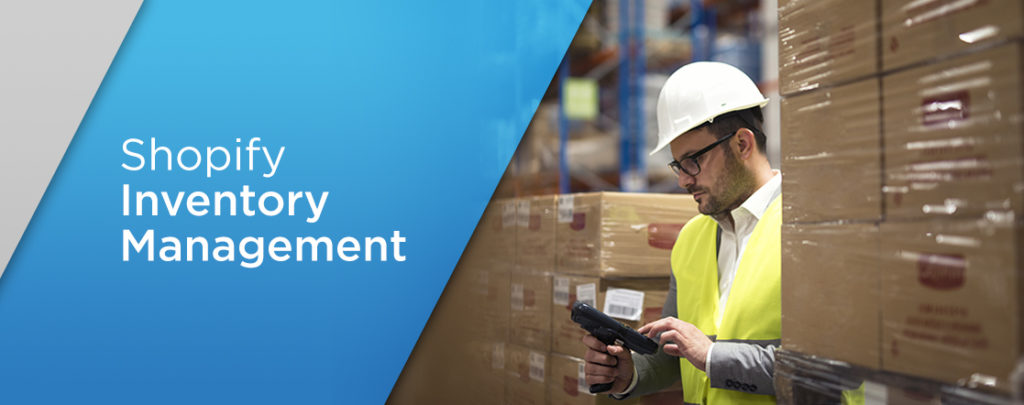

Whether you sell online, in-person, or at special events, you need a way to make sales, collect payments and keep track of your inventory. Shopify is a platform designed to help businesses sell products. The company got its start when its founder was looking for a way to sell products online, but realized there wasn't a simple e-commerce platform available.
In the decade since it launched, Shopify has evolved and grown. Today, it can be used to sell online, sell in brick-and-mortar settings or a combination of the two. The e-commerce platform is also easy to integrate with Finale Inventory, centralizing inventory management and sales. Learn more about Shopify and the benefits of integrating it with your inventory management software.

What Is Shopify?
Shopify is a commerce system that is designed to help businesses sell products. Although the company began as an e-commerce platform, it now has options for businesses that sell online, over social media, at special events or in brick-and-mortar stores. Shopify's online store allows retailers to get an e-commerce shop up and running quickly. Shopify POS is the company's point-of-sale system that allows for omnichannel selling.
What Are the Uses and Benefits of the Shopify Online Platform?
Shopify online is a feature-rich platform that's designed to simplify the process of selling online. A few benefits of the platform's features include:
- Allows you to create an attractive online storefront: The Shopify e-commerce platform lets you build a custom online storefront and company website. The platform offers dozens of professionally designed themes as well as the option of working one-on-one with a website expert to produce a truly customized website and store. Additional features include the option of producing a mobile-optimized website and a blog.
- Streamlines the checkout and payment process: With the Shopify online platform, you can give shoppers a secure way to checkout with multiple payment options. In addition to letting you accept credit cards, the platform integrates with more than 100 payment options, such as PayPal and bitcoin. Additional shopping cart features include automatically calculated shipping rates, the ability to offer free shipping, and automatically calculated sales taxes. If a shopper starts the checkout process but then abandons their cart, the platform can send an email to follow up and encourage them to complete their purchase.
- Lets you manage customers: The Shopify platform makes it easy to manage customers and makes it easy for shoppers to return to buy more from you. Customer accounts can store people's information, such as preferred shipping addresses and payment methods. Customer profiles offer you insight into your shopper's habits, while customer groups let you sort shoppers based on location or purchase history.
- Helps you market your store: You can use Shopify to expand your store's reach and to connect with new customers. The platform integrates with social media networks and is designed to allow for SEO best practices. It also gives you the ability to target specific customers with promotions and discount codes.
- Easily integrates with inventory management software: While you can use Shopify to manage your store's inventory, the platform also allows you to connect with a separate inventory management software, such as Finale Inventory. Using Shopify with Finale Inventory helps you avoid problems such as overselling.
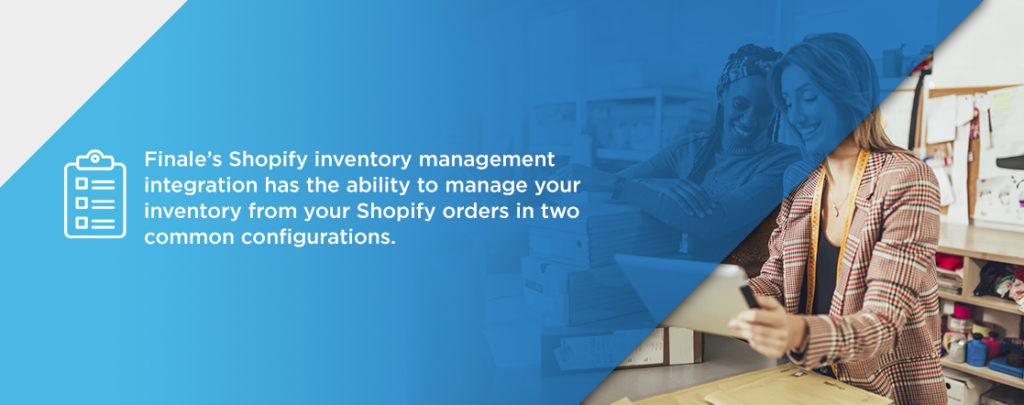
Shopify Inventory Management Integration
Shopify's in-app inventory management features work well for businesses just starting out. As you add new sales channels and your inventory library grows, managing your stock manually becomes more challenging. Integrations with inventory management tools like Finale Inventory can streamline stock management significantly. They let you access advanced data about your inventory and automatically reconcile inventory data from Shopify with your other sales channels. They can also support sophisticated inventory management operations such as restock forecasting.
Advanced inventory management tools will automate many inventory tracking operations that are manual when using Shopify alone. For example, Finale Inventory will automatically push stock quantities to Shopify, drawing on data from your sales and purchase orders. It can also predict when you'll need to restock and generate auto-populated purchase orders right in the app. When you mark new purchase orders as received, the updated quantities will transfer to Shopify immediately. Finale Inventory's Shopify API for inventory management gives your online store real-time data to prevent stock-outs and overselling.
You can track your inventory from your Shopify orders using Finale Inventory in two different configurations. The first integration setup allows for a direct link between your Shopify store and Finale Inventory. Shopify online orders will automatically sync to the software, and Finale Inventory will make the proper stock adjustments. Any sales coming from your Shopify site will automatically subtract from your global stock and auto-update to Shopify and any other sales channels relying on that inventory data.
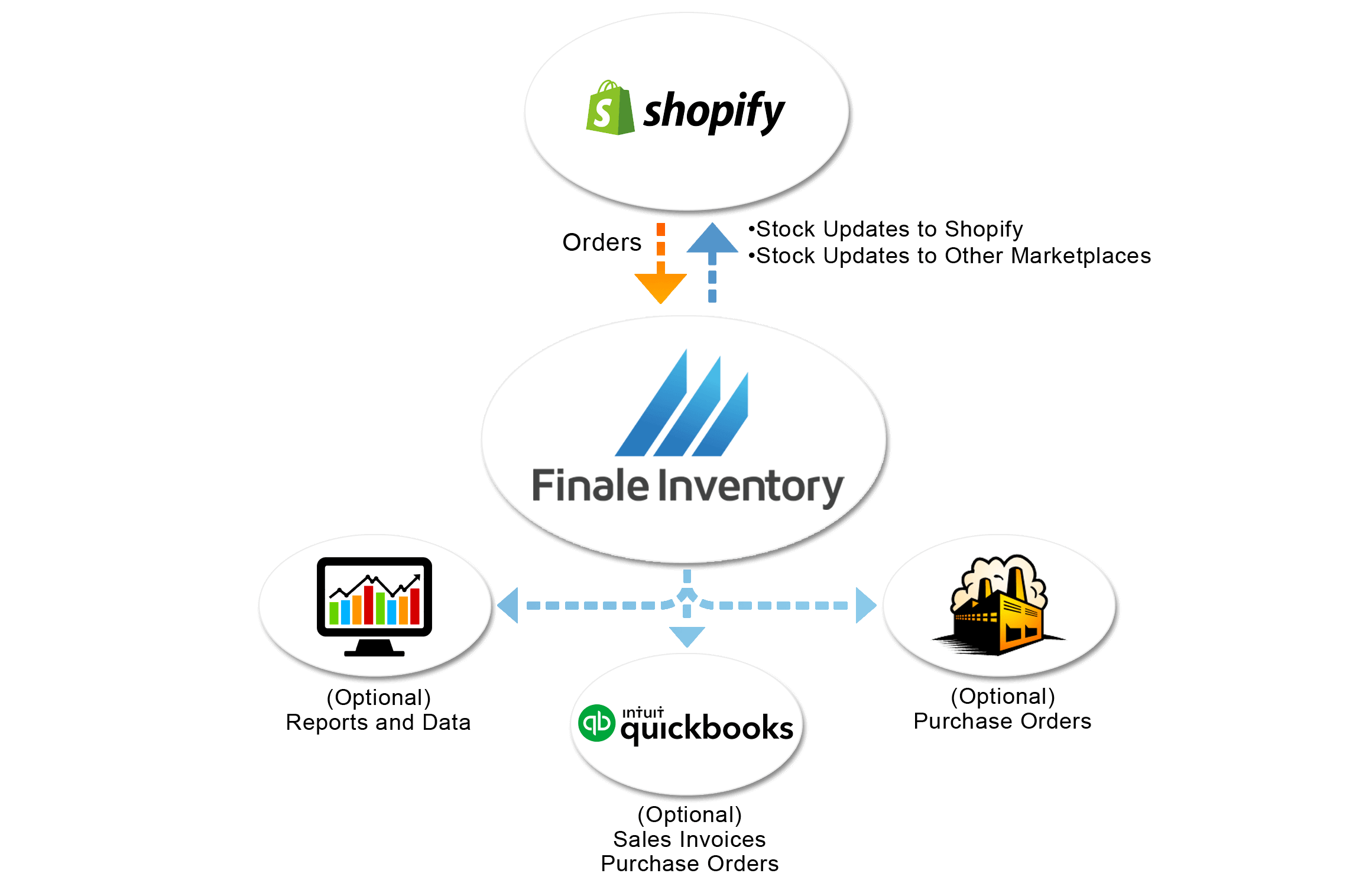
The software will also decrement inventory from your Shopify POS transactions. The Shopify POS inventory configuration is an ideal solution for sellers who primarily sell in their physical store and also sell online. With multiple location support, when a POS transaction occurs at the physical storefront, Finale Inventory allows for stock to be tracked as separate or shared inventory for your brick-and-mortar and online channels.
Any quantity changes resulting from a stock operation will be updated to Shopify within five minutes to prevent overselling. Whether online or in-store, positive adjustments from purchase order shipments or negative adjustments from sales shipments are all accounted for.
Integration with Shopify takes seconds to set up. All you have to do is install the Finale Inventory app on your Shopify account. There are no other changes required to sync your orders to the software and start tracking your inventory for both online and POS orders.
The other configuration option available to Shopify users is through your shipping management software. If your company uses ShipStation or another platform to fulfill orders, you can add Finale Inventory to your shipping management and Shopify POS package. Finale Inventory will keep track of your available stock without interfering with the shipping processes you already know and love.
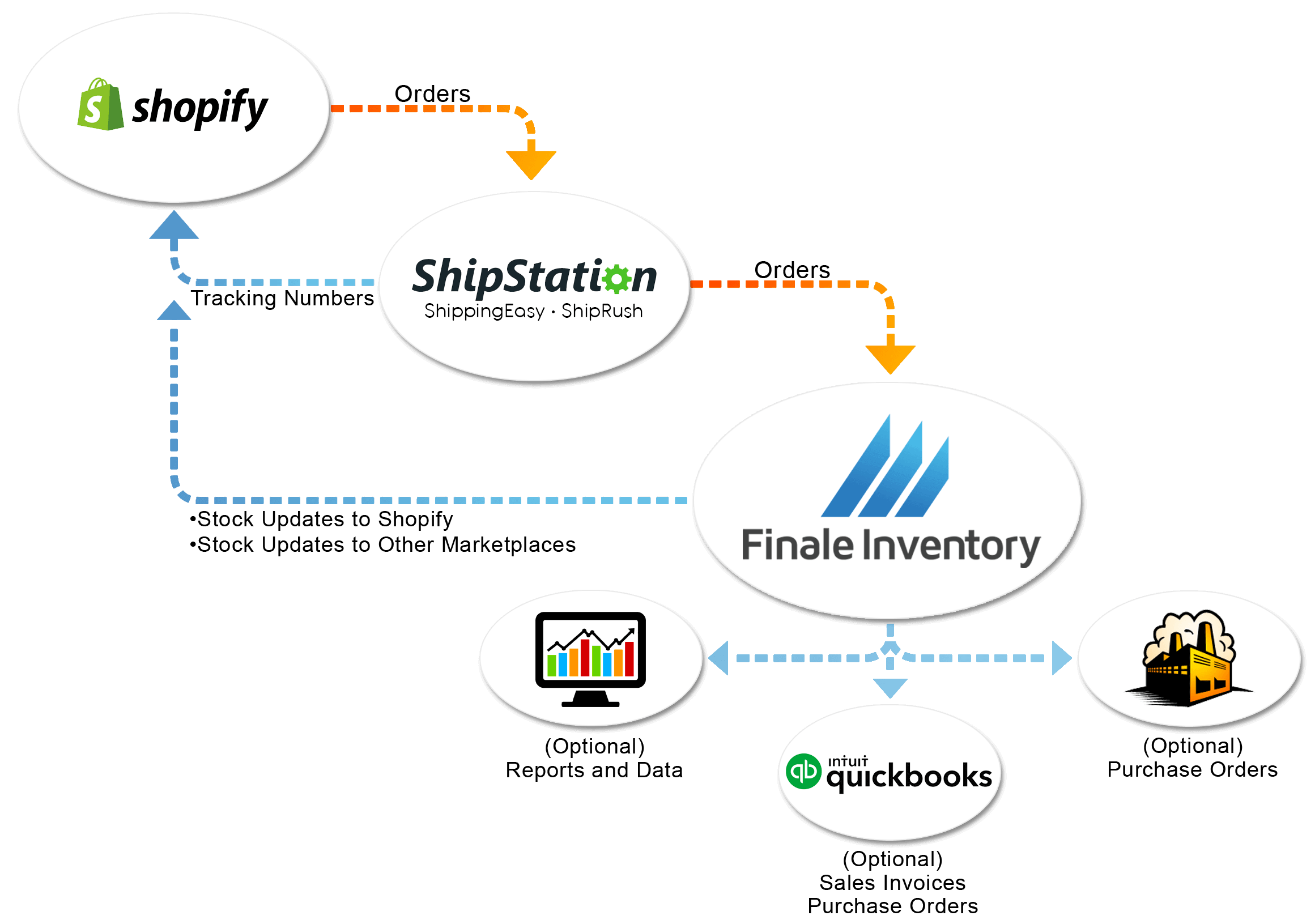
Using ShipStation's API, Finale Inventory communicates with all your software tools behind the scenes to watch the orders that are marked complete. Then, it seamlessly records the transaction to remove the items from inventory. Once this is complete, it will update stock quantities to Shopify and any other online marketplaces simultaneously.
This integration configuration with Finale Inventory is simple and quick to set up. The only thing required is your ShipStation login credentials. You won't have to make any changes to your ShipStation account or any shipping processes to start syncing orders to Finale Inventory and effectively manage your stock.
Shopify and Finale Inventory Management Integration Benefits
The ability to make sales, accept returns and track customers is just part of the retail process. Your business also needs to make sure it has the products available to sell to customers. Integrating Shopify with Finale Inventory offers multiple benefits for your business in this area, including the following.
1. Automatic Updates to Your Shopify Store
Whether you're selling physical products, digital services or tickets, there is likely a finite number of items you can sell at a time. In the case of physical products, you may have a few hundred stored in your warehouses or available for drop-shipping. Tickets are limited by the capacity of the venue. Services are usually limited by your schedule.
Though these limits exist, overselling is a common problem - especially among new businesses. If the demand is higher than you anticipated, you may sell items or services quicker than you're able to update your stock.
For customers, few things are more disappointing than placing an order with a company only to receive a "Sorry, we're out of stock" email a few days later. When you make sales through multiple channels, it's easy for wires to get crossed and items to sell out, even after a customer has put in an order. To minimize that risk, it's vital that stock levels be updated and maintained regularly.
If you aren't using an inventory management software program, you need to do the stock level updates manually. If you sell an item on Instagram or eBay, you'll need to go into your online sales inventory and mark the sale. This process can be time-consuming and creates a lot of opportunity for error. As your sales volume increases or you increase the number of sales channels, manually updating stock becomes even trickier.
Finale Inventory will manage all customer orders and keep track of stock in every location. The inventory management software tracks stock levels and automatically updates them to each selling channel every five minutes.
2. Shared or Separate Inventory Tracking
If you have multiple selling channels, you'll need to consider how to manage the stock for each channel. When multiple channels are picking from the same stock basket, it can become challenging to keep up with inventory.
Integrating Finale Inventory into your e-commerce platform helps make Shopify inventory tracking simpler across your sales channels. The software gives you the option of separating your inventory so the online channel gets a certain number of pieces and your offline channels get their own inventory. You can also track the inventory as shared by all your selling channels, if you prefer.
There are benefits to separating inventory and to using a shared inventory system. When you track inventory separately, there is little risk that one channel will deplete all the available stock before another channel can get to it. Separating inventory can be particularly useful if you are about to launch a new product. You can assign a certain number of units to your online channel and have the rest available in stores. If the product "drops" online first and sells out before it becomes available in stores, customers who missed the online launch will still have a chance to purchase it in stores.
Shared inventory tracking can be useful if your company is new and you aren't sure what items will sell well on each channel. If you have both a physical retail location and an online store, it may turn out that your brick-and-mortar sales are more robust than your online sales. Tracking inventory under one big umbrella will eliminate the guesswork of trying to figure out what will be popular on which channel.
3. Restock Forecasting
You might feel a bit like Goldilocks when it comes to restocking your inventory. You want to find the happy middle - the restock level that's "just right." If you place an order for more inventory too soon, you can wind up having to rent more storage space or dedicate additional warehouse space to a product.
If you wait too long to reorder, you risk running out of an item. Customers who want to buy the item will have to get "sold out" messages or a backorder notice. Depending on how loyal customers are to you or how exclusive your products are, they may go elsewhere to make their purchase.
Finale Inventory takes the guesswork out of restocking. The software uses a dynamic reordering points system to determine the best time to place an order. The points system is created based on the information you provide, such as:
- Anticipated sales growth: This covers how popular the product is or how popular you think it will be based on seasonal demand and other factors. You can adjust the expected sales growth based on the time of year or as the popularity of an item wanes.
- Your safety stock levels: What's your "comfort zone" for a particular product? Some businesses like to have a lot of stock on hand to minimize the risk of sell-outs, while others prefer to use a just-in-time inventory management system, keeping only what's needed at the moment in stock.
- Supplier lead time: Where your stock comes from and how it's made also determines when you need to reorder it. If your inventory is custom-made or the manufacturer needs a lot of lead time, you'll need to place a restock order sooner compared to a company that sells mass-produced goods with a quick production timeline.
- Sales velocity: How quickly an item is selling also influences its need to be restocked. If sales are slow, the dynamic reordering points system may be adjusted downward so you don't end up with more product than you need.
Finale Inventory's restock forecasting feature takes one more thing off your plate. When you use the feature, you'll get an alert whenever the inventory of a particular item dips to a certain level. Along with alerting you to the need to reorder, the software will also handle sending out the purchase order and updating stock levels when the shipment arrives.

4. Product Kitting
If the popularity of meal deals and subscription boxes is any indication, people love bundling products together. Bundles, or product kits, help people save money while letting businesses sell more products. After all, what's better than selling one bottle of shampoo? Selling a bottle of shampoo plus a bottle of a conditioner.
One challenge that arises with product kitting is managing the inventory. Should you set a certain number of items aside to be sold in a bundle and only in a bundle? For example, if you are creating a cold-weather kit with a knit hat, scarf and gloves, how many of each item should you reserve for the kits and how many should you try to sell individually? You may decide not to separate the stock into bundled and individual items, so people have the option of picking and choosing. That way, a person won't be forced to buy a kit if they only want a scarf, and a person who wants all three options will always be able to buy a kit as long as each item is in stock.
Finale Inventory makes it easy for you to create product bundles for sale and to keep track of the stock of the items in the bundle, both together and separately. Using the software, you can create a separate product ID for each kit, then assign child products to the kit. If any or all of the child products are sold out, the kit won't be available for purchase.
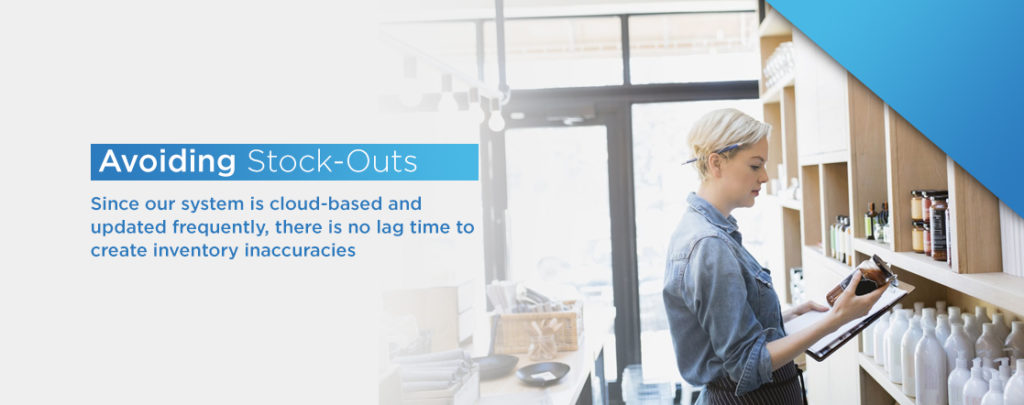
6. Streamline Inventory and Operations Across the Board
Integrating Shopify into Finale Inventory helps you streamline your operations across the board. Some of the ways it does so include:
- Support allowing multiple stock-keeping units (SKUs) for a unique product ID: When you are selling products in different marketplaces like Shopify and Walmart, you may be forced to have different SKUs for the same product. Many customers manage this unnecessary complexity with Excel worksheets. The software handles this with a couple of mouse clicks to easily map multiple marketplace SKUs to a single Finale product ID.
- High-transaction volumes support: Conduct a large number of monthly transactions? No problem. The inventory software can support up to 800,000 transactions per month, and we are scaling our architecture to support even higher volumes. High transaction customers should consider leveraging our integrated turnkey mobile bar code solution to decrease warehouse operations times from receiving and picking while improving accuracy.
- Multiple shipping location support: As one of the best Shopify inventory management solutions, Finale Inventory can track inventory housed in multiple warehouses or fulfillment centers. You can log sublocations for each of your products and easily transfer stock between warehouses. By viewing inventory levels per warehouse, you can make strategic decisions about which warehouses to fulfill orders from and which warehouses need to be restocked.
- Status change automation: When products are back-ordered, orders containing those products are typically marked as "On Hold" in ShipStation. When those products are received in your warehouse and recorded in Finale, Finale will automatically change the order status from "On Hold" to "Waiting" in ShipStation.
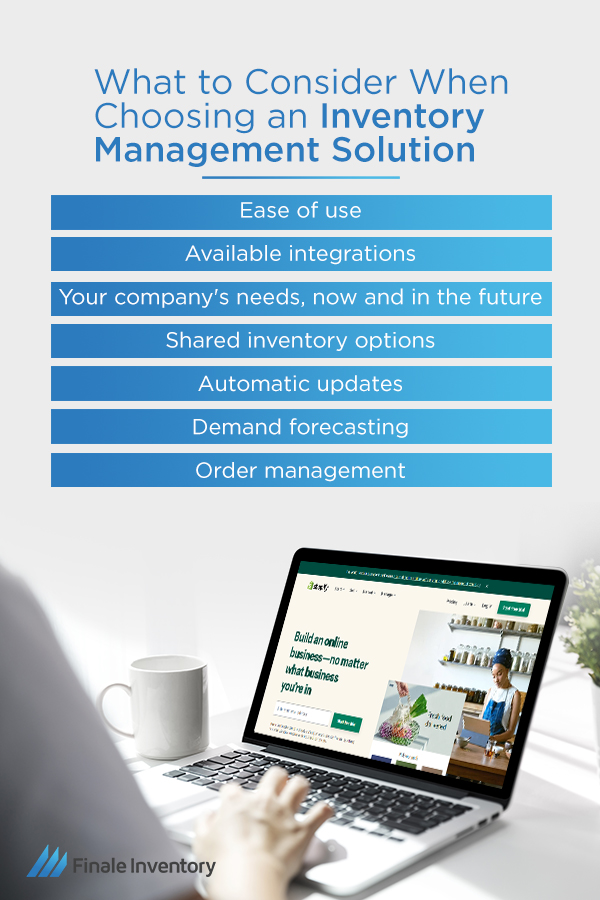
What to Consider When Choosing an Inventory Management Solution
Integrating an inventory management system into your Shopify platform can help you avoid stock-outs, customer disappointment and inventory-related issues. But what's the best way to manage your inventory with Shopify? As you choose your inventory management software, here are a few things to look for:
- Ease of use: Setting up your inventory management system and integrating it with Shopify and your other sales channels shouldn't give you a headache or have you calling tech support every 15 minutes. If you decide to use Finale Inventory with Shopify, the process of connecting the two programs is quick and easy. You don't have to adjust anything on the back-end or make changes to your account, beyond installing the Finale Inventory app.
- Available integrations: Many businesses sell in more than one location these days. If you're on Amazon, eBay, or Etsy and you have your own shop, you want a system that will work with all those platforms and will let each platform communicate with each other. It's also helpful if your inventory management software works with other programs you might use, such as QuickBooks and ShipStation. If there's the option of customizing integrations, that can be even more helpful. Finale Inventory integrates with a wide range of programs and also gives you the option of creating a custom integration.
- Your company's needs, now and in the future: What your company needs today may not be the same as what it needs in one month, a year, or five years. It's helpful to look for an inventory management solution that works for you now and offers the option of growing with you so it continues to meet your needs in the future.
- Shared inventory options: If you sell across channels, you may benefit from software that gives you the option of sharing inventory across those channels. The minute a sale takes place on Amazon, the inventory on eBay, your own shop, and other sales channels should be updated to minimize the chance of overselling or stock-outs.
- Automatic updates: In today's digital world, sales take place every minute. Someone may be shopping at your online store at 2 a.m. To keep things up-to-the-minute, it's essential your inventory management solution offers automatic updates. Finale Inventory updates stock every five minutes, so your records are always the most accurate and up-to-date.
- Demand forecasting: You may not be able to predict the future, but you can invest in software that accurately forecasts your inventory needs based on current sales and shopping patterns. Demand forecasting means you'll always have stock ready-to-go and won't have to worry about overstocking an item or running short.
- Order management: An inventory management software that simplifies the ordering process can be a real boon to your company. Finale Inventory can take care of reorders and purchase orders for you, meaning there is one less thing to worry about.
Contact Finale Inventory for a Free Trial or Real-Time Demo
Inventory issues can be a thing of the past. When you integrate Finale Inventory into Shopify, you get a centralized inventory tracking system that helps you stay on top of sales and efficiently manage your online and offline inventory. To learn more, schedule a demo of our software or sign up for your free trial today.





